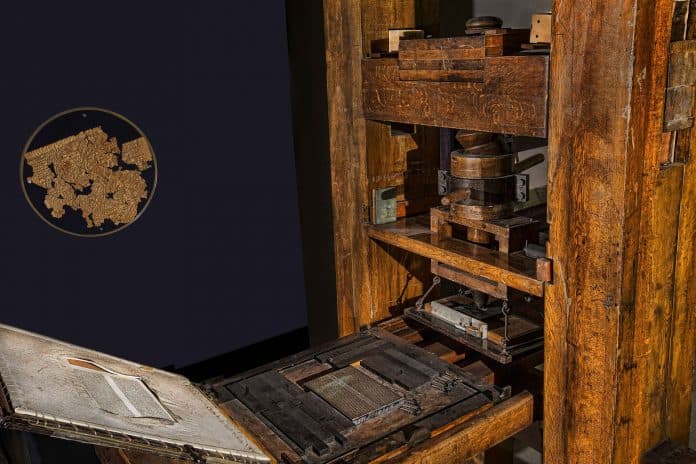Last updated on March 19th, 2024 at 12:33 pm
Back in the 15th century, the gutenberg press revolutionized the world of print. The first printing press enabled mass production of uniform printed products, such as books, newspapers, pamphlets and more. Though this method originated in China, it wasn’t until Johannes Gutenberg and his invention of the printing press (called the Gutenberg press) came onto the scene that it really took off in Europe. Let’s dive a bit deeper into the invention and importance of the printing press to society.
What was the Gutenberg press?
Modelled after a design that consisted of screw presses, a single printing press could produce up to 3,600 pages per work day. To put that into perspective, hand-printing produced about forty pages per workday.
But how does the printing press work? Basically, it was a machine that enabled text and images to be transferred to paper or other media by means of ink. A long handle was used to turn a heavy wooden screw which exerted downward pressure against the paper that was laid over the type mounted on a wooden plate.
In hindsight, it was quite a simple machine. But despite this, why was Gutenberg’s printing press so important?
Why was the Gutenberg press important?
Johannes Gutenberg’s printing press left a lasting impression on society and vastly improved how books are produced. This invention allowed for books to be printed both in a timely manner and at a low cost. Imagine if we still had to write whole books out by hand? Talk about carpal tunnel. Not only would this take forever, it would cost quite a bit to get someone to do that. The first large-scale printing done using the Gutenberg press was a set of 200 illustrated Latin bibles in 1455. This took roughly 3 years. Every single copy was pre-sold before the last page had even been set. By 1500, at least half a million books had entered circulation. These printed works ranged from Columbus’ account of the New World to classical Greek texts.
But to truly answer the question “why was the printing press important?” you’ll need to see its impact in every time period since it was invented.

The Role of the Printing Press in the Renaissance Movement
The significance of the Gutenberg printing press can be clearly seen in the Renaissance movement, helping Europe pull out of the Dark Ages, further accelerating human progress. Access to educational materials was now opening up beyond the higher class, as more and more printed books became available and at lower costs. A major project of the Renaissance was to find and republish long-lost works by people such as Plato and Aristotle. Quite a bit of time and money was invested in the search for these works. The invention of the printing press was able to help speed up the process of publishing these texts in a way that hadn’t been possible before its invention. While the printing press didn’t launch the Renaissance era, it certainly helped accelerate the rediscovery and sharing of knowledge.
The Scientific revolution
Francis Bacon, an English philosopher, wrote in 1620 that the three most important inventions to forever change the world were gunpowder, the nautical compass and the printing press. For the longest time, handwritten copies of scientific data were hard and expensive to come by, and also subject to human error. Gutenberg’s invention enabled these scientific findings to be published and shared with a significantly wider audience than ever before.
Censorship
Before the invention of the printing press, censorship was relatively easy. All someone needed to do was kill the “heretic” and destroy all of their notes, which likely didn’t consist of many. Once Gutenberg’s printing press entered the scene, censorship was significantly more difficult to enforce. Destroying all copies of a dangerous idea was not as easy, as there were many more in circulation. The more dangerous a printed book supposedly was, the more in demand it was. Any time the Church published a list of banned books, booksellers knew what they would need to print next. The books on that list.
The Industrial revolution
Though the industrial revolution didn’t really begin until part way through the 18th century, the printing press is credited with having brought the idea of machines “stealing jobs” from human workers into the world. Scribes were in high demand before the invention of the Gutenberg press, as bookmakers would employ dozens of them to hand-copy manuscripts. The printing press essentially made them obsolete. On the other hand, the increased demand for printed material sparked the creation of a brand new industry of printers, brick-and-mortar booksellers and street peddlers. One particular person that got his start as a printer’s apprentice was Benjamin Franklin.
Printing in the 21st century
While the Gutenberg press remained unchanged for many years after its invention, the printing industry has changed and evolved significantly since. Not only are materials able to be printed on an even larger and faster scale than ever before, people are able to do their own printing from the comfort of their home. The printing revolution is still evolving today.
The invention of the press had a lasting impression on the world, considering it is referenced in history texts and still talked about to this day. By allowing for written text to be mass produced at a faster pace and lower cost, this invention played an integral role in the spreading of knowledge and evolution of humanity. By allowing citizens other than the richest of the rich access to educational materials, knowledge was able to be passed down and spread at a much faster pace.







